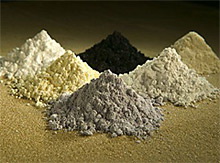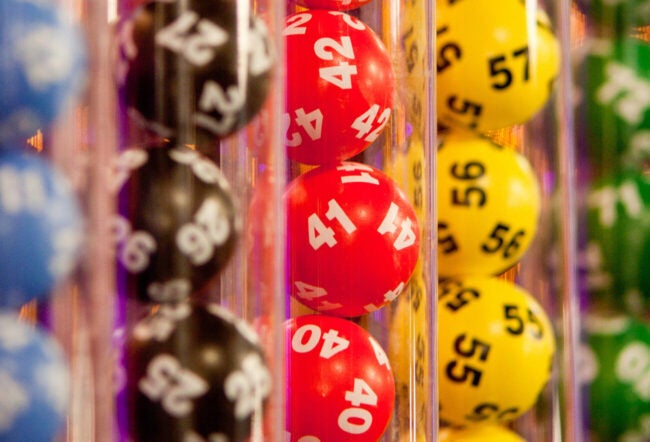Rare earths are a collection of 17 elements from the periodic table with tongue-twisting names like scandium, yttrium and dysprosium. Not especially rare, they are strategically vital for many high-tech industries, and are among the few natural resources that China has in relative abundance. Since it has become the de facto main supplier for almost all of the exotic metals, accounting for 97% of the market, Beijing’s control over their export can have far-reaching consequences for the global economy.
That was clear when news broke in September that China ordered traders to halt rare-earth shipments and was reducing their export quotas. Governments around the globe swung into action to ensure access to those commodities, which are needed to manufacture a host of goods — from catalytic converters and smart phones to wind turbines and electric vehicles as well as the tiny electric motors that control the guidance fin on missiles and smart bombs. “The effect awakened everyone to their vulnerability in relying on China as their sole source of supply in the medium term. In the long term, people are looking at other areas of vulnerability,” says Patrick Chovanec, professor of economics and management at Tsinghua University in Beijing. While China has eased up on its restrictions subsequently, “this rare-earth issue is front and center on everyone’s radar screens.”
No Chinese government official has gone on record saying the country had stopped shipments of rare earths, first to Japan and then to the U.S. and the European Union. But observers reckon China’s rare-earth shipments to Japan were affected as part of the diplomatic fallout following the collision of a Chinese fishing trawler and two Japanese patrol vessels near disputed islands in the East China Sea (called Diaoyu in China and Senkakuin Japan). As for the U.S. and EU, the embargo reflects Beijing’s displeasure about the awarding of the Nobel Peace Prize to jailed dissident Liu Xiaobo.
While the US-EU embargo lasted 10 days, ending on October 28, Japan’s continued for more than two months. But Beijing’s de facto export suspensionappeared to be ending on November 29, when Sojitz, Japan’s largest rare-earth importer, confirmed that it expected the arrival offour cargoes carrying 66 tons of rare earthsfrom China, the first since late September.
Flag Waving
China’s minister of commerce, Chen Deming, insisted in a television interview on September 26 that his government had not imposed any restrictions on rare-earth shipments to Japan. He maintained, instead, that Chinese companies might have done so on their own because of negative sentiment toward Japan. But 10 of the 32 companies in China allowed to export such materials are foreign and presumably would lack such acute sentiments in the absence of government pressure.
Japan and the U.S. have raised the issue with China at various international meetings, most recently during the Asia Pacific Economic Cooperation forum in Yokohama, Japan, with little sign of progress. What’s more, the lack of transparency among China’s decision maker has left understanding what their next moves are likely to be open to speculation. But analysts agree that even if the embargo began as spontaneous action by low-ranking customs officials, it has since become a matter of unspoken national policy. “I suspect the Chinese government might have chosen the moment as a signal to Japan. I wouldn’t be surprised if the government used this rare-earth issue as bargaining chip,” says John Gong, an economics professor at the University of International Business and Economics (UIBE) in Beijing.
Beijing’s intent seems obvious to Soichiro Nakamura, a Japanese rare-earth trader and president of the Shanghai subsidiary of rare metal company Japan UMC. “The Chinese government wants to give Japan a hard time after the Senkaku islands incident in September,” he asserts. Antagonism over the collision on September 9 deepened after Japan took the captain of the Chinese boat into custody, raising strenuous protests in Beijing. The Chinese skipper was released on September 24, but feathers on both sides remain ruffled. “It seems the Chinese side is saying it doesn’t intend to use [rare earths] as a kind of bargaining tool. I would like to calmly deal with this issue after determining how China will respond,” Japan’s Prime Minister Naoto Kan said in a November 14 press conference.
For the moment, China appears to have the upper hand, given its status as holder of the world’s largest reserves of rare-earth materials, with 36 million tons. The Commonwealth of Independent States (CIS) has 19 million tons, the U.S. 13 million tons and Australia 5.4 million tons, according to the U.S. Geological Survey’s “2010 Mineral Commodity Summaries.” Of particular concern are supplies of dysprosium, increasingly used as a magnet material in hybrid vehicle motors and magnetic disc drives for personal computers.
Left Exposed
The story of how China became such a dominant supplier might sound familiar to companies in other sectors. The country’s ability to produce the metals at low cost, and tolerate the highly polluting mining methods involved, led it to overtake the U.S. as the main supplier in the mid-1990s. By 2002, the U.S.’s biggest producer, the Mountain Pass mine in southern California owned by Colorado Molycorp, had shut down.
Given the scarcity of alternatives, many manufacturers have been left exposed to potential supply disruptions, especially Japanese auto and electronics makers. Japan imports about 90% of the rare earths it uses from China.
In 2007, long before the current controversy, China began gradually reducing its rare-earth export quotas, seeking to exert stronger control over the industry. In July, it suddenly issued a notice that its total export quota will be cut by 72% in the second half of this year, to 7,976 tons from 28,417 tons in the same period a year earlier. As a result, the total export quota for 2010 is 30,258 tons, down 40% from 50,145 tons in 2009. China’s total annual output is about 120,000 tons, the majority of which being used domestically.
Many experts reckon Beijing is using its export quotas to exert leverage in other areas, similar to tactics used by OPEC in manipulating crude oil supplies. “The Middle East has oil; China has rare earth” as the late Deng Xiaoping, mastermind of China’s economic reforms, is quoted saying in 1992.
“China is looking at OPEC and wants to raise rare-earth prices by cutting back its supply and introducing the export quota system,” observes UIBE’s Gong. “The Chinese government wants world rare-earth prices to rise.”
With China’s state-owned companies scouring the globe for supplies of oil, gas and other resources, Beijing is obviously aware of the influence it can wield, states Toru Okabe, a professor with the Institute of Industrial Science at the University of Tokyo, who specializes in rare-earth metals. “A long-term strategy of the Chinese government is to control exports of rare earth without any warning or abruptly. I have pointed out many times that China may manipulate prices high-handedly or could use rare earths as a diplomatic tool,” he says.
China maintains that it is doing no such thing and that its tighter export quotas are required to protect the environment and better regulate the industry. State media reports that the government may cut exports by another 30% in 2011, despite Commerce Ministry denials. The ministry contends that if China keeps output at its current 120,000 tons a year, it will deplete its rare-earth reserves in 20 years. But other experts question that logic, saying supplies are sufficient to last a century or even two. “I would assume the reserves would last for a long time and would not run out that quickly. I do not understand why they are saying that,” says Okabe. China’s rare-earth demand is about 72,000 tons, or about 54% of world demand, according to Lynas, the Australian owner of one of the richest rare-earth deposits in the world. Japan uses 32,000 tons, the U.S. about 11,000 tons and the EU 13,000 tons.
If China’s abrupt changes were the result of long-term strategic needs, “they communicated [that] terribly. If you have 97% of the world supply and you are going to change production, for conservation of rare earths or environmental reasons, you have an obligation to coordinate with your customers,” says Chovanec. “You tell them your plans in advance so that no one panics.”
With supplies shrinking, prices have been soaring. The price of cerium oxide, used for polishing semiconductors, climbed sevenfold in the six months to November 18 and prices for other elements have more than doubled, according to Metal-Pages in London, which tracks world metal prices. The surge is a windfall for China. “China is the land of rare earths in the same way that the Middle East has oil and Australia has iron ore. But China has not enjoyed the handsome profits that those countries have reaped from their control over precious resources,” noted a recent editorial in Guangzhou-based newspaper 21st Century Business Herald.
While their government disavows any intention of manipulating the market, Chinese experts acknowledge that the country has a strategic goal of pushing for higher prices. “China is the largest producer and exporter of rare earths, but it does not enjoy enough rights to set the price in the international market,” wrote Guo Chaoxian, a scholar with the Institute of Industrial Economics at the Chinese Academy of Social Sciences, in a recent commentary in state-owned English newspaper China Daily.
Stockpiling Strategies
Although Japanese manufacturers are facing some supply shortfalls, the cut in shipments has not seriously affected them, since they have been stockpiling rare earths. Japanese traders estimate that the stockpiles range from one month to a few years. Sojitz, a major Japanese rare-earth importer, forecasts that Japan will suffer a shortage of 10,200 tons in 2011 even if China keeps its current export quota at 30,000 tons and resumes shipments.
Beijing’s policy has been carried out in such a way that importing countries have limited options to respond and are unlikely to be able to take complaints to the World Trade Organization (WTO). “The way the Chinese government works is not as transparent as in the U.S. or some other countries,” Chovanec says. “U.S. trade actions against other countries require a fairly transparent process of hearings, reports and conclusions. But none of this occurs in China. It is very hard to verify if they are imposing an embargo and to decide if we should take the case to the WTO.”
Still, China’s moves could have unforeseen and undesired consequences for Beijing. Most importantly, it has shaken confidence among trading partners that it is a reliable supplier of strategically important materials or products, says Okabe. “I did not expect such a strong action as an embargo. China will lose the trust of the international community in the long run,” he predicts. Given its own reliance on imported natural resources, like oil, copper and iron ore, such behavior seems unwise, Chovanec adds.
While rare-earth prices rise in the short term, other countries with reserves are being spurred to bring production back online. “Supplies from the U.S., Australian and other countries will emerge. That may not be best for China,” says Gong.
Alarmed by the troubles with China, Japan is rushing to diversify its rare-earth suppliers, recently clinching agreements with Vietnam and Mongolia on joint rare-earth mining. Tokyo allocated 100 billion yen (US$1.2 billion) to improving rare-earth supplies in its supplementary budget for the fiscal year ending March 31, 2011. The funds are to be spent on overseas mining projects, research and development of alternative materials, and facilities for recycling rare earths from used computers, cars and cell phones.
Japan’s Sojitz signed on long-term supply deal on November 24 with Lynas, owner of a A$550 million (US$541 million) rare-earth project at Mount Weld, near Laverton in Western Australia. Itwill allocate between 8,000 tons and 9,000 tons a year to the Japanese market over the next 10 years. Initially, the two aim to ship between 1,000 tons and 3,000 tons in the third quarter of 2011. Lynas will begin production in the third quarter in 2011. Its initial output of 11,000 tons a year is expected to double to 22,000 by the end of 2012..
China Nonferrous Metal Company (CNMC) had tried to acquire Lynas in 2009, but the Australian Foreign Investment Review Board blocked the deal for national security reasons. The state-owned company gave up its bid, citing stiff conditions imposed by the investment board, which had demanded CNMC cut its ownership stake to below 50% and takeonly a minority of board seats in Lynas.
Molycorp of the U.S. has likewise announced plans to resume production at the Mountain Pass mine in California, aiming to produce 20,000 tons of rare earths by late 2012. Meanwhile, Japanese trading house Sumitomo is developing mines in Kazakhstan and plans to start rare-earth shipments from Vietnam from 2013. Other Japanese trading houses, such as Toyota Tsusho, are also preparing for rare-earth development in Vietnam. “Japan will be able to secure stable supplies from reliable countries. Rare earths are all over the world,” says Nakamura of Japan UMC.
He says Japan’s search for alternative resources could result in China losing all or some of the Japanese market, the world’s biggest. “China will suffer the most when Japan has access to other rare-earth resources. Even if prices fall, Japanese companies will not use Chinese rare earths at all given the high risks this time,” Nakamura asserts. “In the end, China did not win this game.”
All told, the rare-earth issue has raised awareness of the strategic implications of China’s growing assertiveness and economic influence in other sectors, leaving many more wary of how they deal with Beijing. “China is flexing its muscles more and more. If that is the case, you want to minimize your exposure to that kind of pressure,” Chovanec says.
Beijing has set a “dangerous precedent,” adds Gong.



